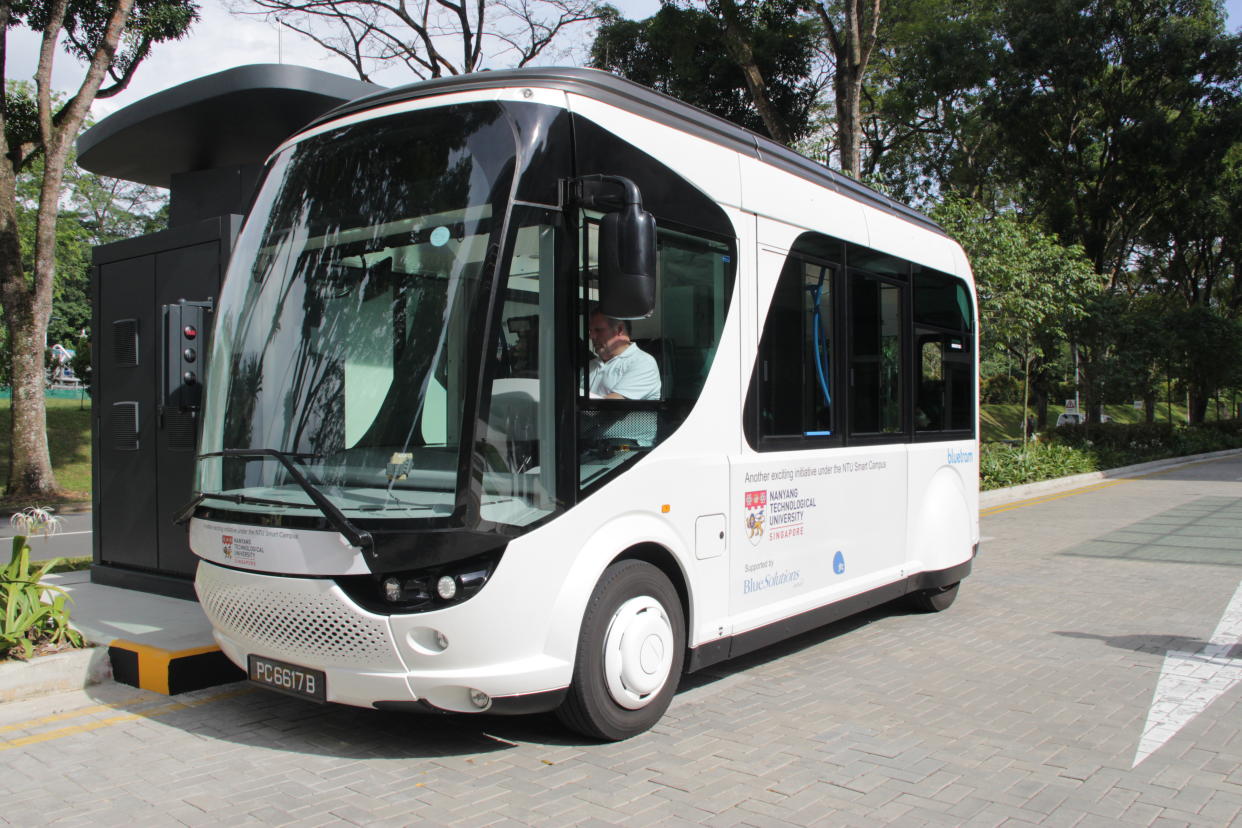Electric shuttle trial rides between NTU and JTC's CleanTech One to start from July

From July this year, Nanyang Technological University (NTU) students and teachers can travel between NTU’s Halls of Residence at North Hill and Jurong Town Corporation (JTC)’s CleanTech One on Singapore’s first flash-charging electric shuttle as part of a trial programme.
Launched on Monday (January 22) by NTU and electric vehicle car-sharing company BlueSG, which is a subsidiary of Blue Solutions, the NTU-Blue Solutions Flash Shuttle can carry a maximum of 22 people and only requires 20 seconds to fully charge.
The 6-metre long electric shuttle – a Bluetram vehicle by parent company Bolloré Group – is powered by a set of supercapacitors and a lithium metal polymer battery, unlike other electric vehicles that function solely on batteries.
Supercapacitors can be charged quickly and can last for millions of charge and discharge cycles. Their main disadvantage, however, is their small energy density – the amount of energy they can store per unit weight is minute compared with batteries.
On a single charge, a shuttle can travel up to two kilometres, with backup battery power that allows it to travel for an additional 30 kilometres.
Two charging stations, one situated at North Hill and the other at CleanTech One about 1 kilometre apart, will allow the shuttle to charge while passengers board and alight the vehicle.
A joint research team comprising scientists from NTU’s Energy Research Institute (ERIAN) and BlueSG will study the road performance of the shuttle in Singapore’s tropical climate as well as assess energy usage for optimal operations.
“Typically, when you take an electric vehicle – car or bus -, the biggest challenge is the charging time. It still ranges from anywhere up to six hours. What we are trialing here is a slightly different concept – a shuttle that charges at every bus stop for 20 seconds,” said Prof Subodh Mhaisalkar, Executive Director, ERIAN. “What it opens up is the possibility that this can run 24 hours…and you don’t need to take it offline.”
Singapore is the second launchpad for the shuttle after it was introduced in Paris in December 2015 to coincide with the 2015 United Nations Climate Change Conference (COP 21) in France.
“With electric vehicles like this, they can go indoors. This can go into the lobby of a hospital, inside the airport, so it brings up new possibilities in public transportation,” added Prof Subodh.
The cost of operating the Bluetram is five to 10 times lower than tram systems as it does not require costly infrastructure like rails or catenary, and a whole line can be deployed “in a matter of weeks”, said BlueSG’s Managing Director Franck Vitté.
For instance, the cost of operating the shuttle in NTU is estimated at €1 million to €2 million ($1.62 million to $3.23 million) per kilometre.
BlueSG is not ruling out autonomous capabilities for the shuttle in the future. “We would like to see how we can develop a self-positioning system for the vehicle to go onto the station, and autonomous driving for the last few metres (of its journey),” Vitté said.
As part of NTU’s Smart Campus initiative, the university is also in talks with BlueSG to install electric vehicle car-sharing stations within the campus by this year.
This will allow NTU students, staff, and faculty to rent a BlueSG vehicle, drive it around Singapore and return it to any BlueSG charging station.
Just last month, the company rolled out the first large-scale sharing service for electric vehicles in Singapore.
The company, which currently has a fleet of 80 electric cars and 32 charging stations islandwide, has registered 3,300 members and more than 5,000 rentals as of end-December.
Related stories:
Volvo’s first driverless buses to be tested in NTU centre in Singapore
NTU aims to become a tech-savvy campus with new Smart Pass, tech courses


